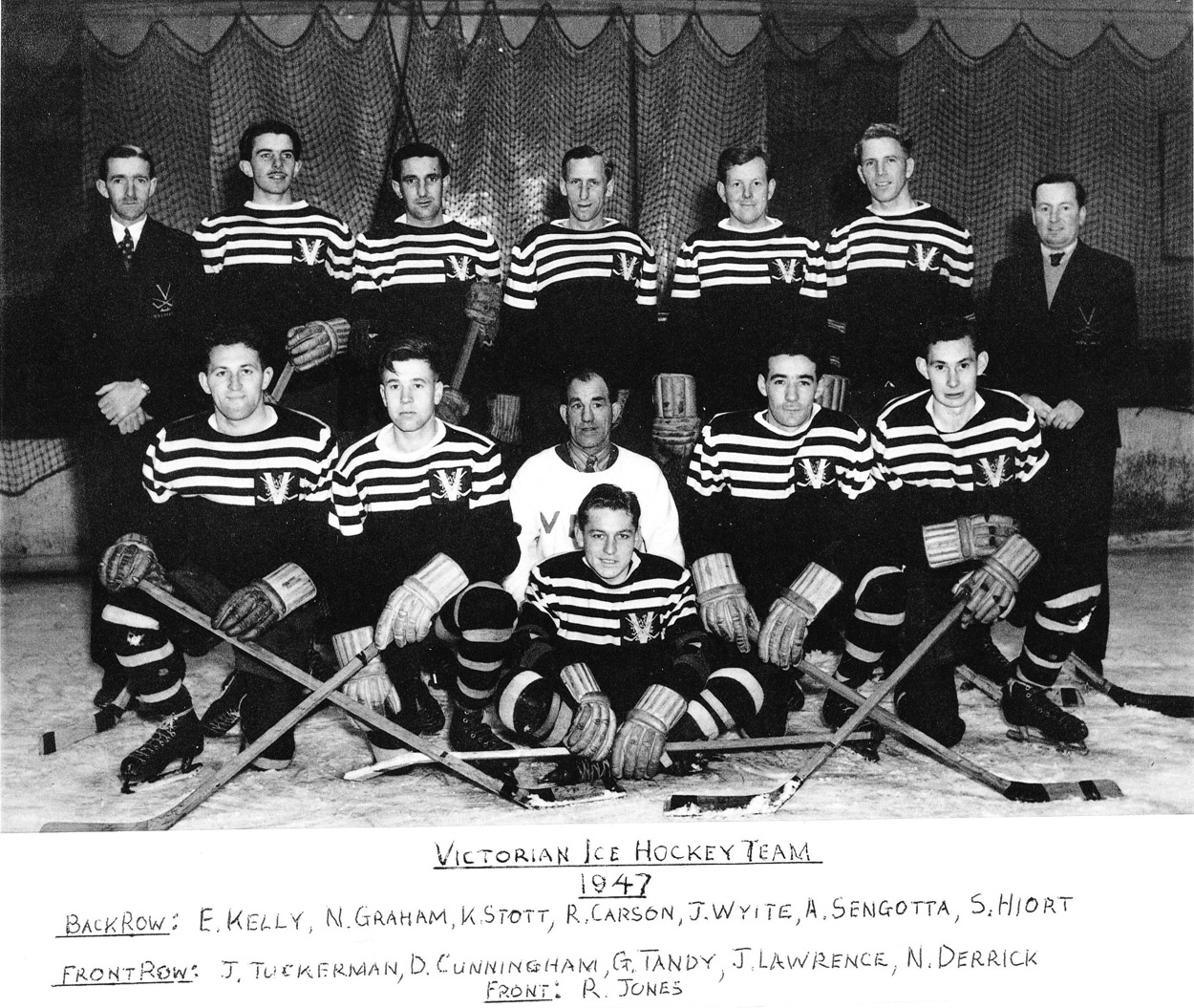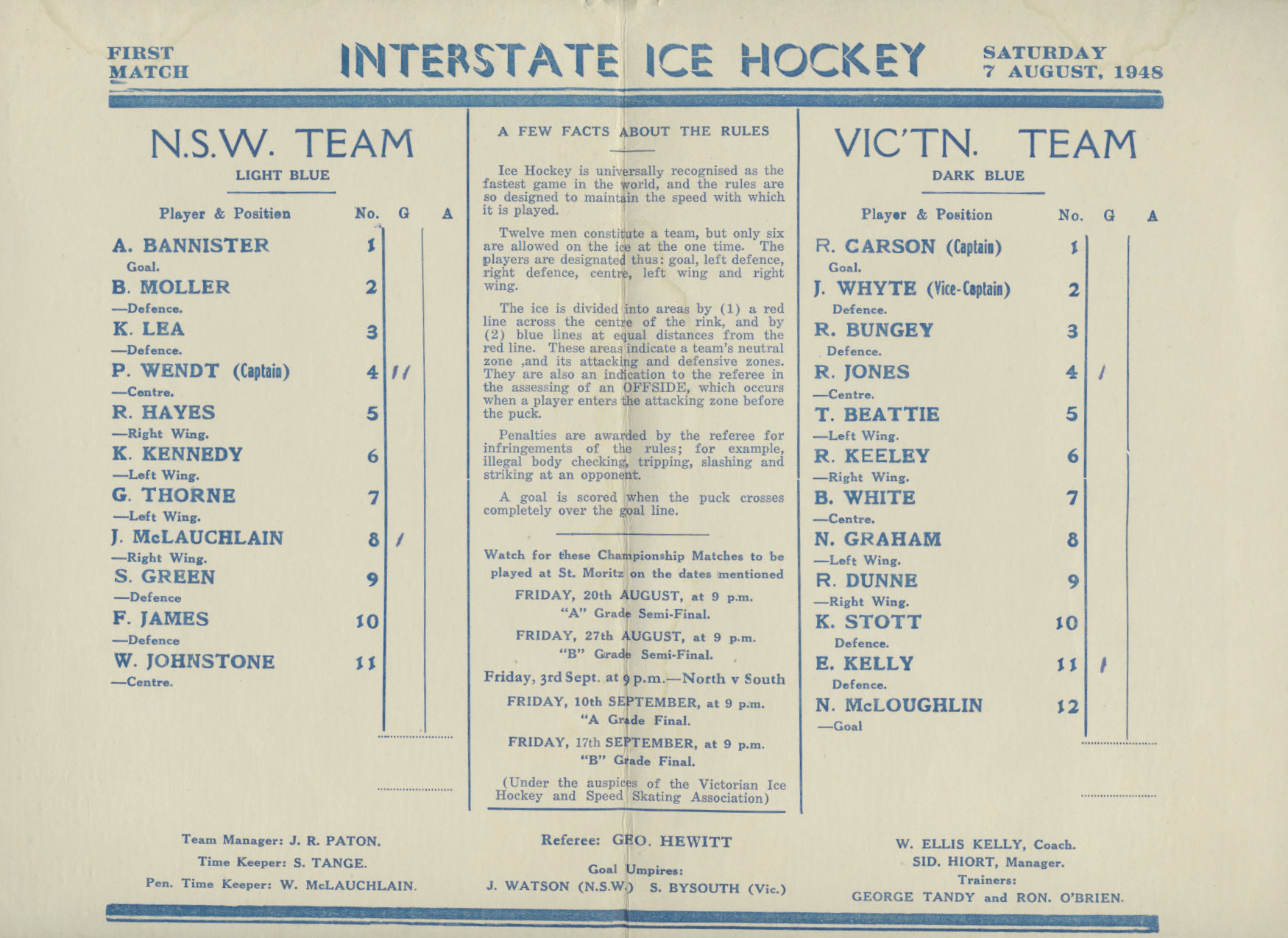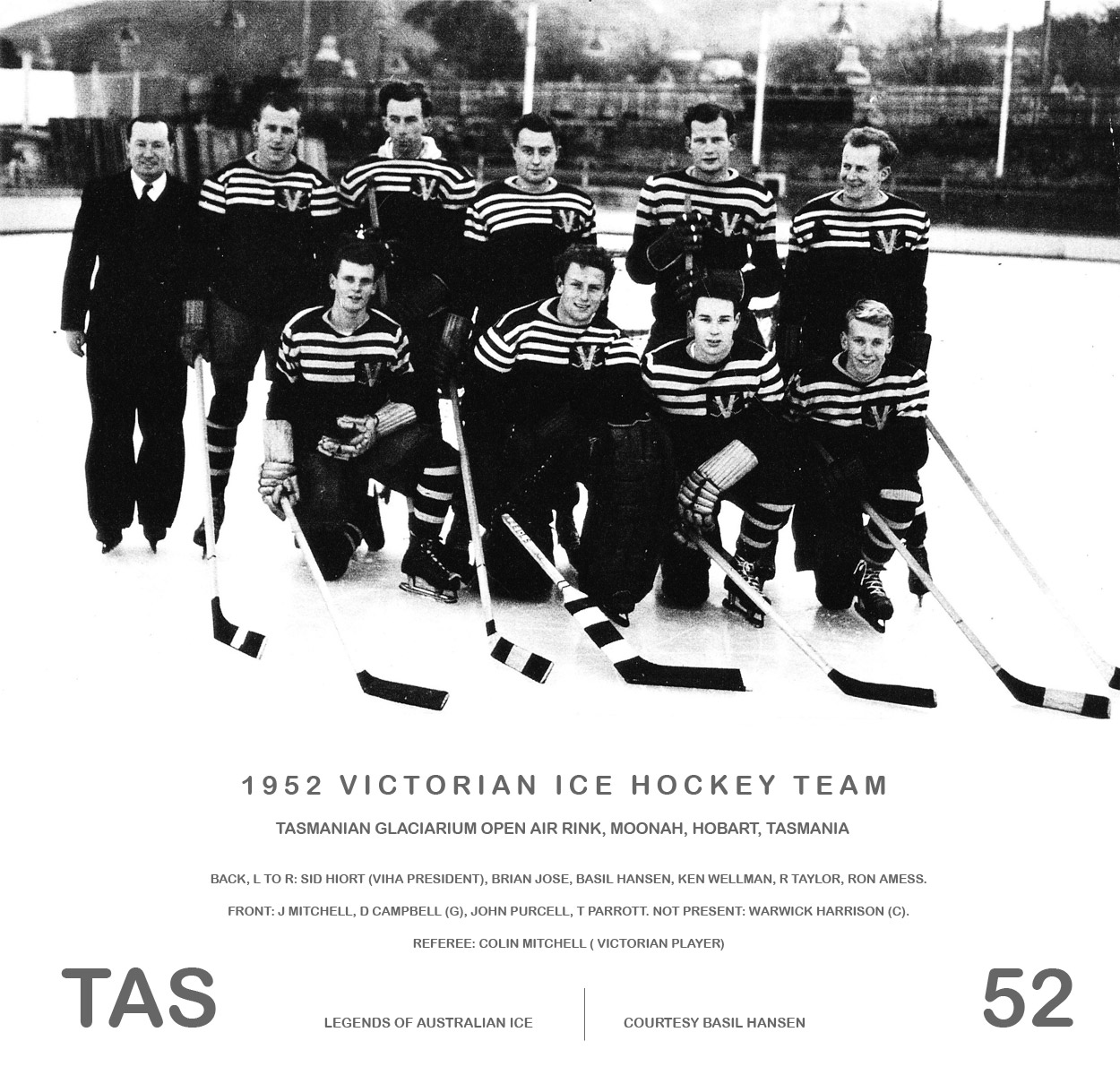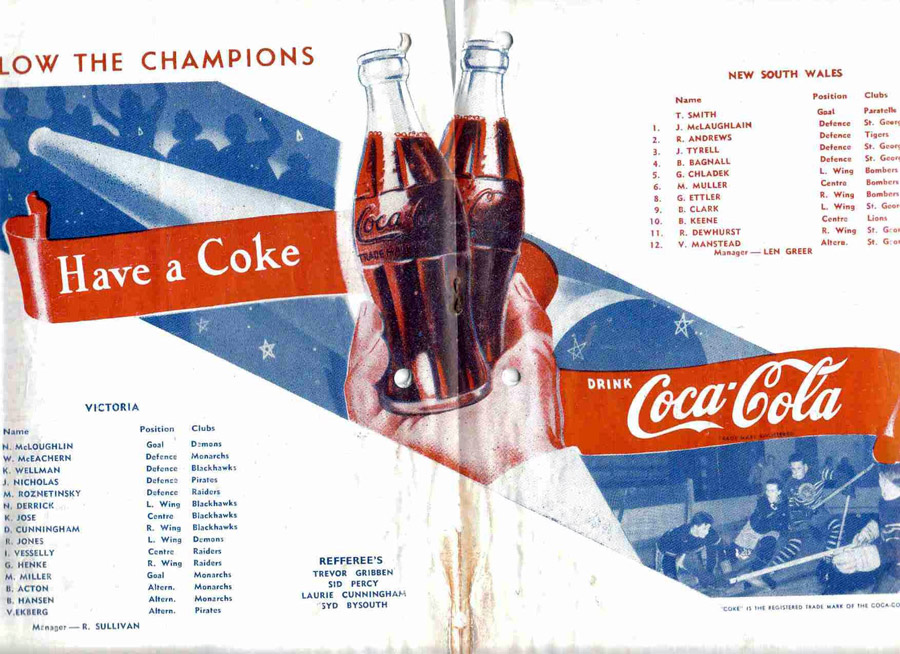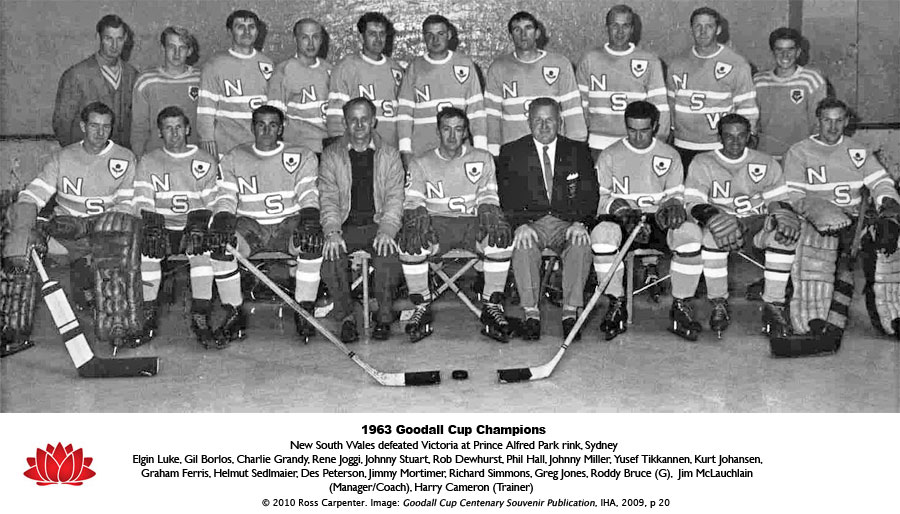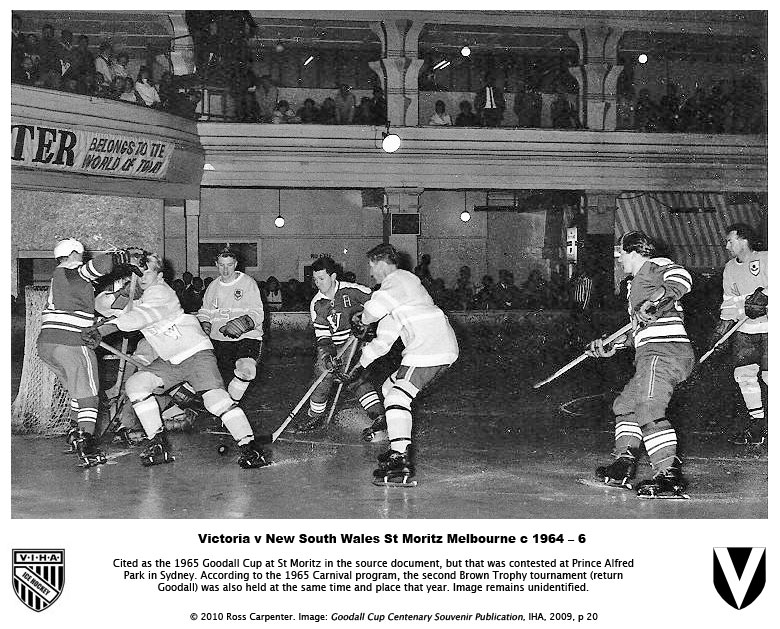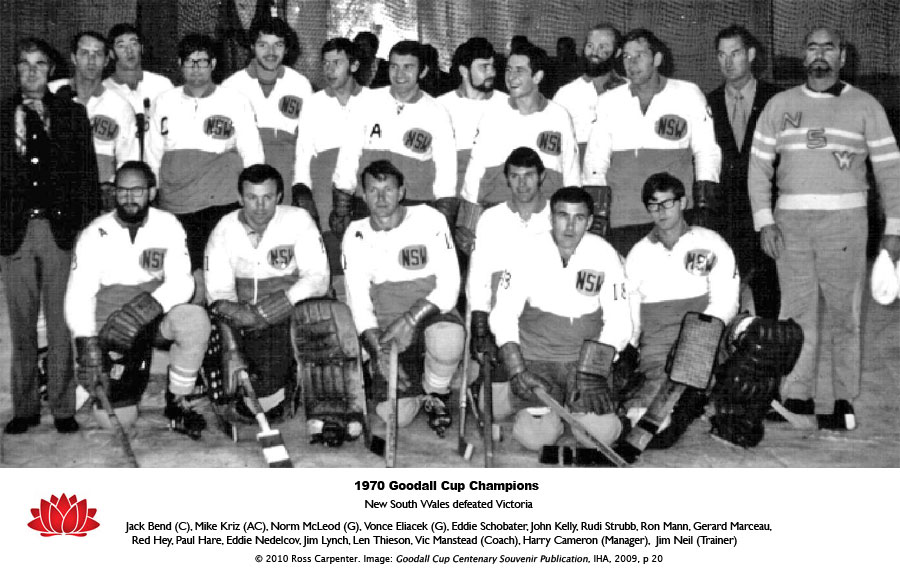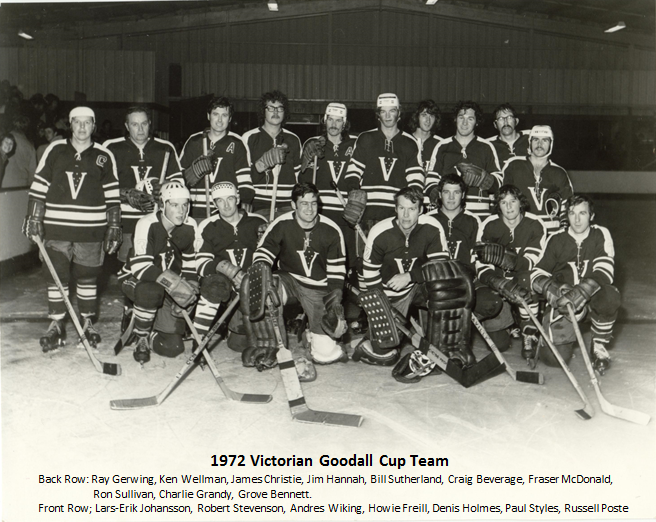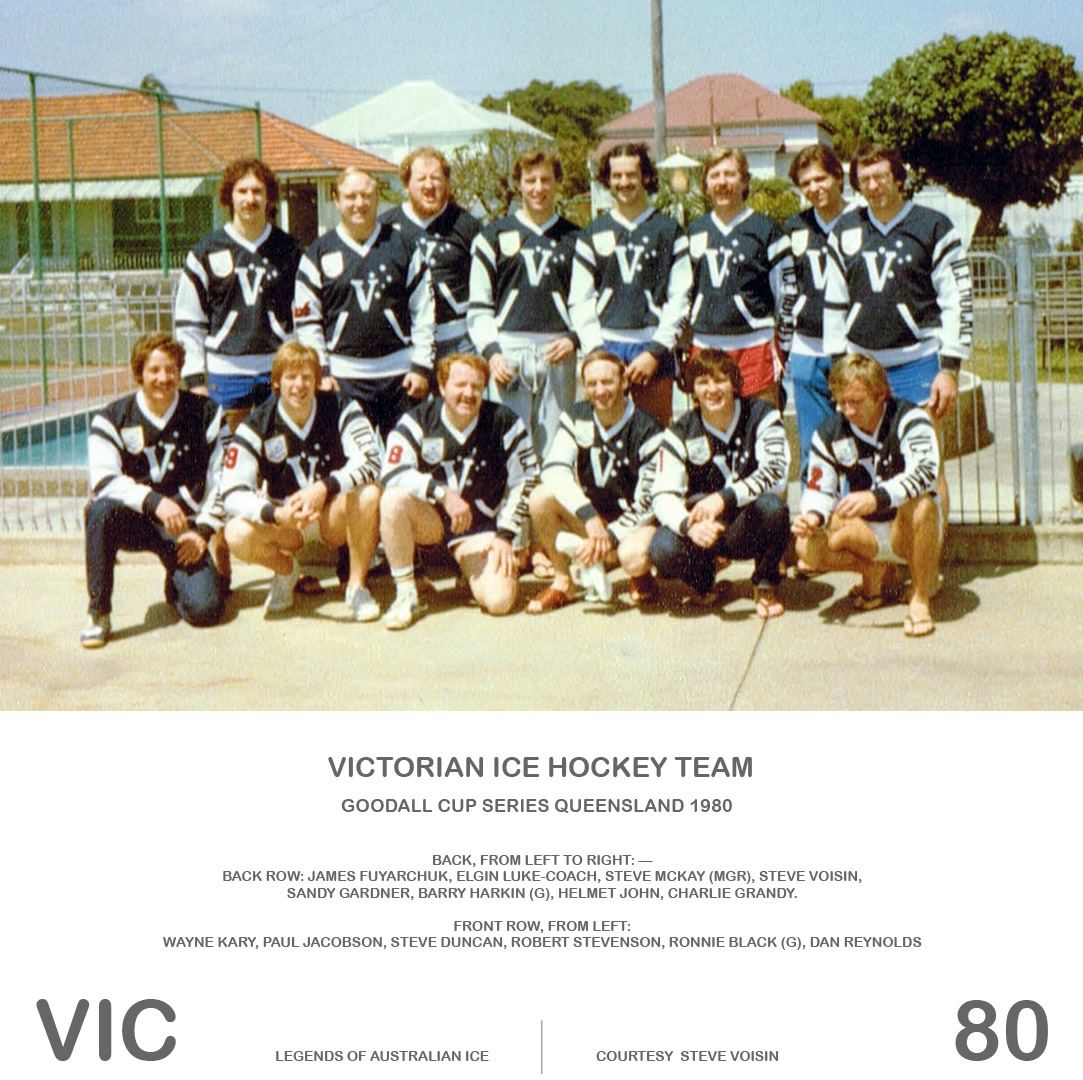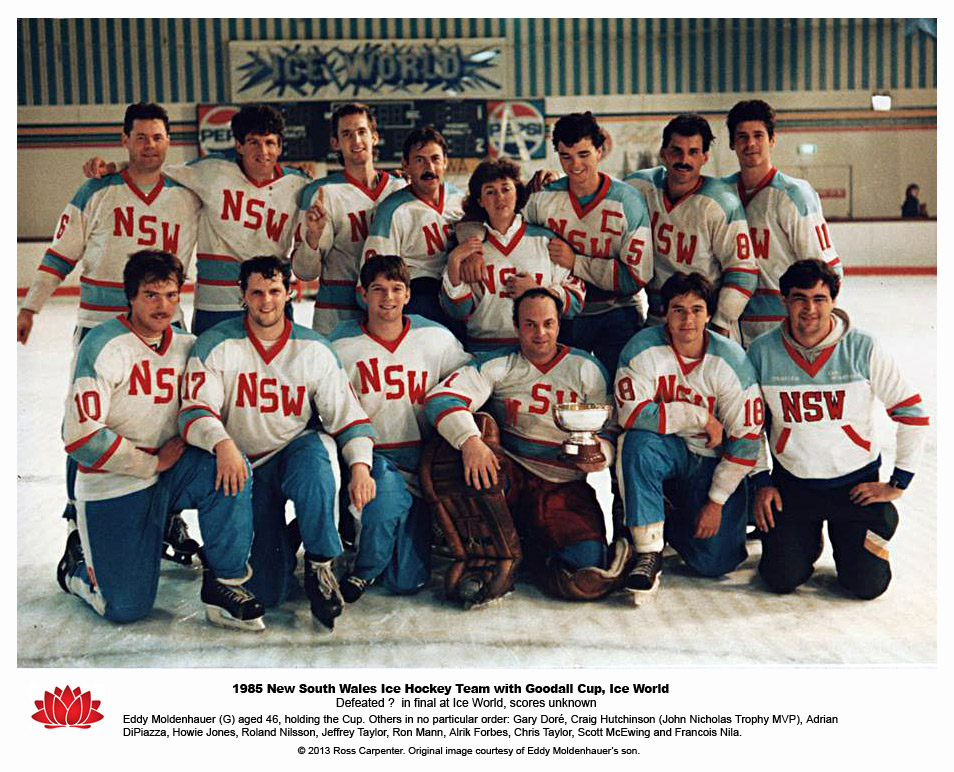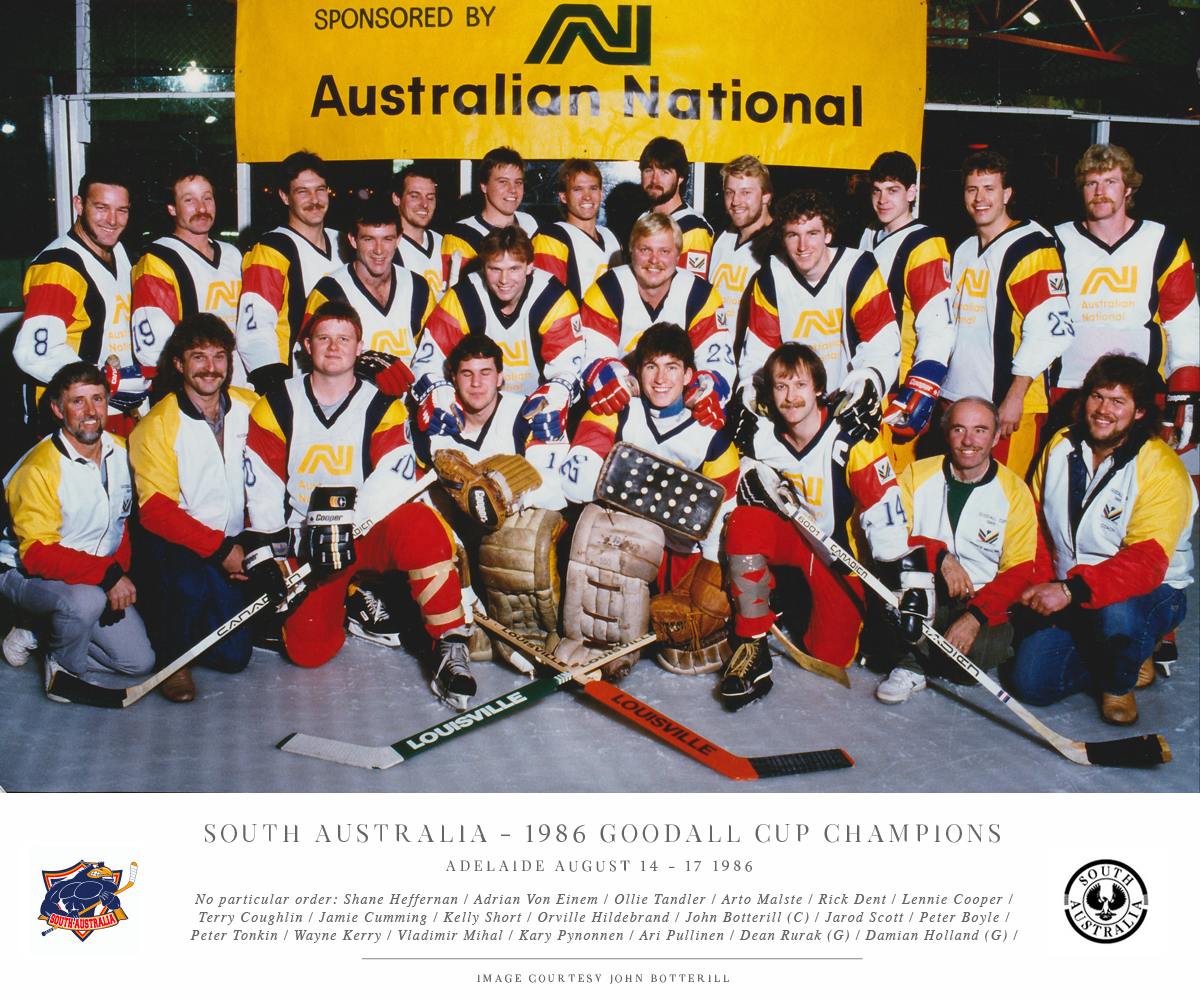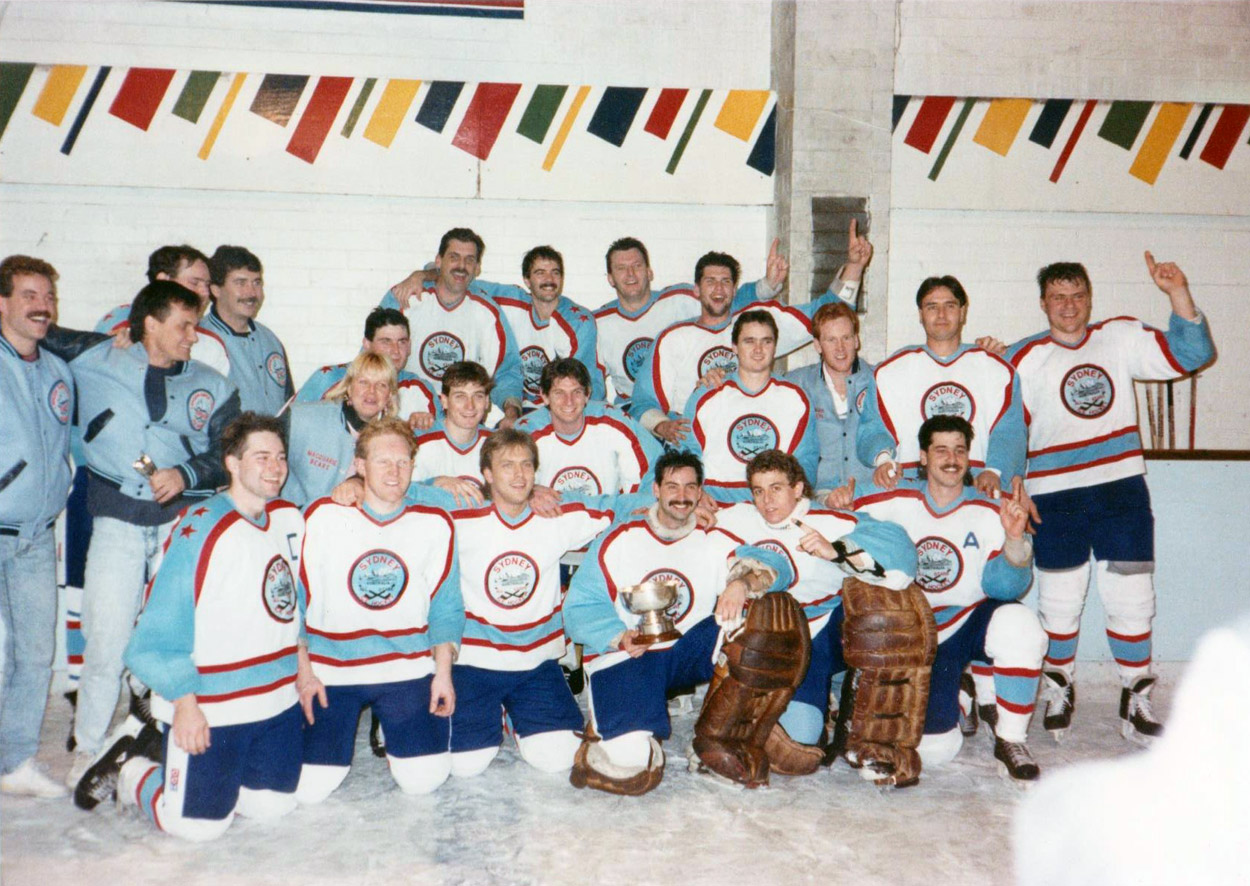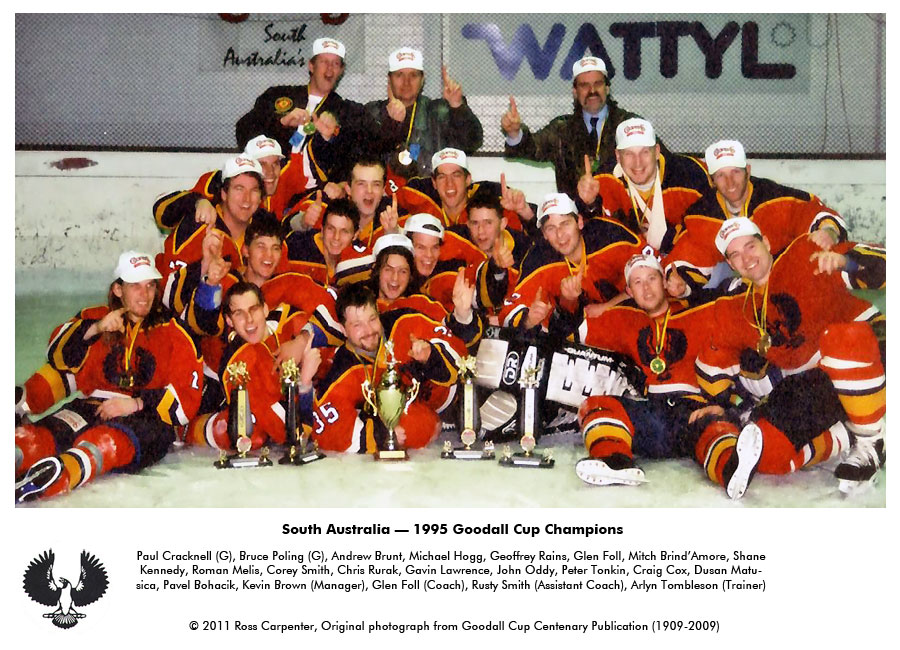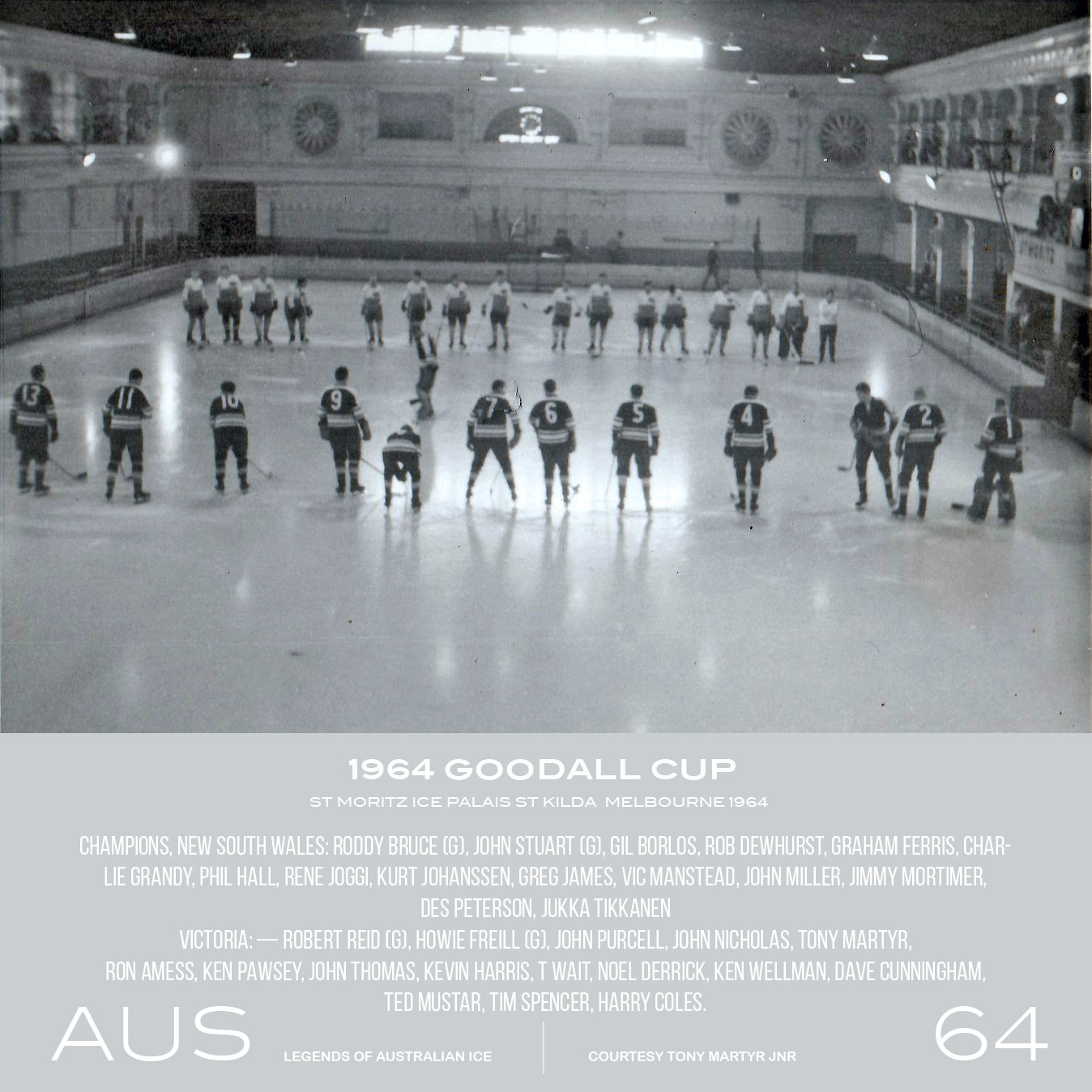
The Story of the Goodall Cup
Part 2: post-war, 1946 to the AIHL
![]() The ice hockey team was not given trips because they were not world class, yet could never become competitive unless they had overseas matches.
The ice hockey team was not given trips because they were not world class, yet could never become competitive unless they had overseas matches.
— Ken Kennedy, 1963 AOC meeting, President of both the New South Wales and Australian Ice Hockey Federations at the time of the 1960 Winter Games [5]
![]() I ask the winter sports whether they really believe they are in world class, or world ranking, in the field of sport and whether they can do Australia credit, or just be there.
I ask the winter sports whether they really believe they are in world class, or world ranking, in the field of sport and whether they can do Australia credit, or just be there.
— Edgar Tanner, member of the Australian delegations to six Olympiads (1952-76). [5]
I thought the first spirit of the Games was to compete.
— Bill Young, manager of the cycling team. [5]
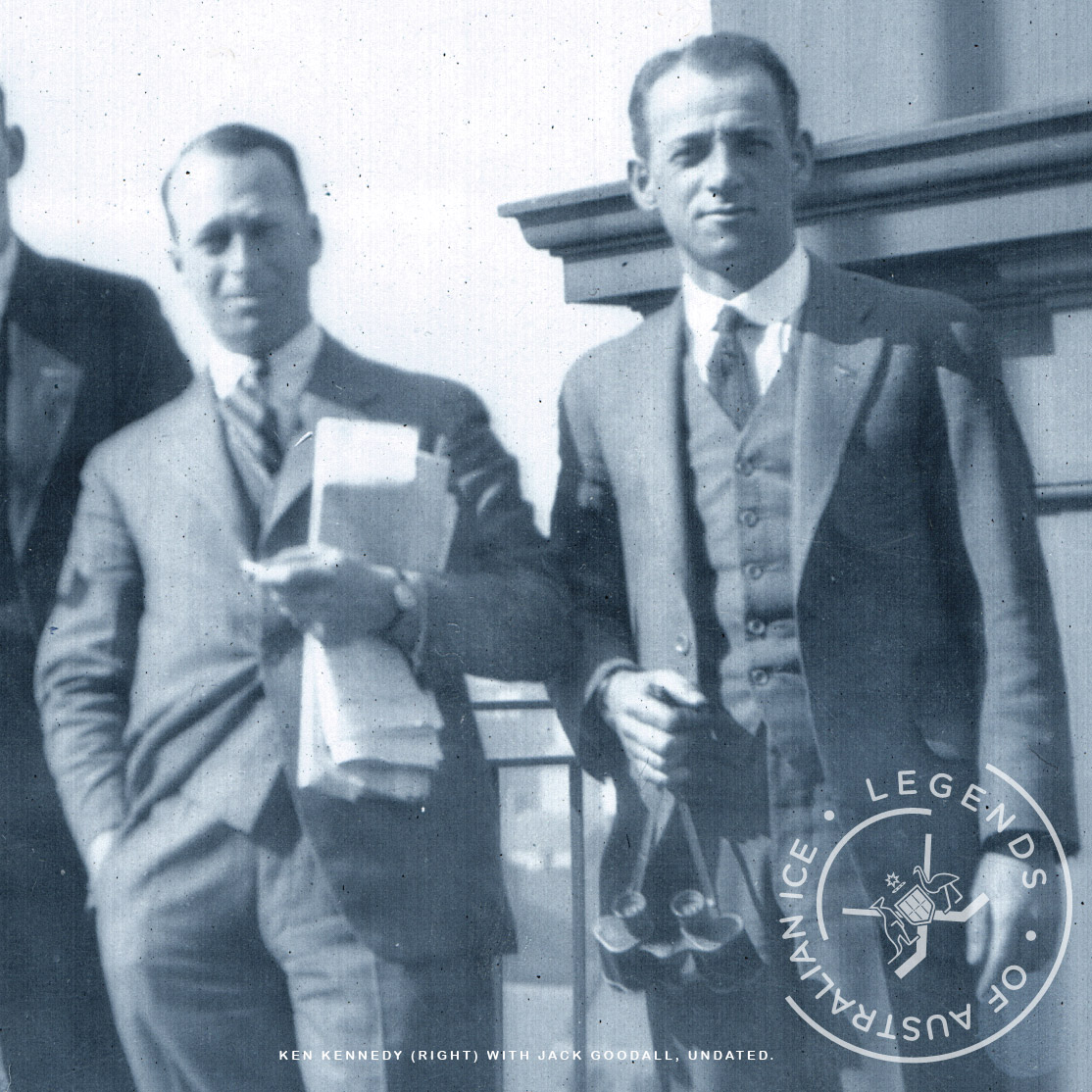 — John Goodall, (left) first national ice hockey association president, and Ken Kennedy who was president after the Second World War. [4]
— John Goodall, (left) first national ice hockey association president, and Ken Kennedy who was president after the Second World War. [4]
New South Wales Goodall Cup team tryouts, Sydney Glaciarium, 1946. There had been no interstate hockey during the war interruption and New South Wales players were trying-out for the first State team since 1939. Victoria tied NSW in three tests that year, 2-3, 2-1, 2-2. It was the first tie since 1932.
ATTENDED BY 5,000 FANS in Melbourne, the first Cup series after the war interruption was also keenly fought. It resulted in a tie, the closest the Vics had come since the only other tied series in 1932. The only returning players were captain, coach and goalie Russ Carson, the two young guns, Dave Cunningham and Rus Jones, and Chook Tuckerman who had been their coach and mentor during their recent development years. Ellis Kelly coached Victoria that year and it was one of the youngest teams the state had ever iced, which was hardly surprising after the 6-year hiatus created by a world at war.
The first test of the 1947 series was rough at times, but Carson was outstanding in net, the local papers reporting the brilliance of the Victorian defence in upsetting the attack of their opponents. In the second match, the Vics opened up a 2-0 lead in the first period with goals from Sengotta and Jones. Thorn for NSW netted the only goal in the second period after skating the full length of the rink.
In the third, Winter scored for Victoria and although it was he who was given most of the credit for finally breaking their opponent's iron grip on the Cup, it was Rus Jones with the game winner in the first and Carson with the magnificent saves in the second.
The elusive grail was lugged back to Melbourne legitimately this time, although that was probably a little disappointing for the Vics' manager, Cliff Napthine, who had rather enjoyed the notoriety of stealing it, when winning it was nigh impossible.
It was not only the pre-War teams who showed a supreme disregard for the welfare of the sport's top bauble. Late in the forties it sailed serenely out of a third floor hotel window and into the night during a demonstration of the difference in passing methods used in rugby and Australian Rules. About that time, Stan Gray's weekly column in the Sporting Globe and his news items in the Herald became ice hockey's most authoritative writings.
The voice of Ron Casey on Radio 3DB crackled to life on Tuesdays around 10 pm, snapping to attention the staff and technicians in the studio at the rear who broadcast it through the twin masts in Flinders Street to a sports-mad city. It was a style of commentary hard to ignore because it gave the listener an accurate picture of the game's action and tactics in a flowing and readily listenable manner.
Casey broadcast local ice hockey action and the VIHA "Lightning Premierships" raised funds for The Sporting Globe-3DB Children's Hospital Appeal that ran all day Good Friday. The Appeal had started in 1931 as a sporting carnival in aid of Melbourne's hospitals and it still runs today, raising millions. Like Casey, Phil Gibbs on Radio 3KZ broadcast League football with Jack Dyer, but he too followed into ice hockey in 1953 and quickly settled down to bright factual descriptions of game play. He drew a big audience by 1954. The media exposure provided in those years by Casey, Gibbs and Gray helped Australian ice hockey hit an all-time peak in popularity in the Fifties.
This coincided with the big change that came with the migration inflow in the late-Forties and early-Fifties. Then we had to wrestle with names like Jan Kurzweil, Miro Roznetinsky, Hans Muller, Emil Buchatsky, George and Tommy Endrei, Al Sengotta and dozens of others who not only bought colour to the game, but plenty of skill and fire too. At the same time, there was a fresh crop of less difficult names like Cunningham, Derrick, Jones, Thorn, Miller, Harrison, Lee and Green. All these and more are linked with the history of the rugged but shiny piece of brassware, the list growing ever longer as the years rolled by.
In 1948, Percy Wendt became captain of New South Wales and won back the Goodall Cup with Kennedy, Thorne, and McLauchlain, then repeated the performance in 1950. But once Victoria regained the Cup in 1947, they dominated losing only eight of the next twenty-eight series until only two victories separated the rival states by 1979. In 1948, over one hundred new players were being coached in Melbourne alone.
The war years had produced the first intensive coaching programs in both States and the first corporate sponsorships for local teams. Rhodes Motorcycle Company sponsored Carson's Topliners and the Foy & Gibson department store chain sponsored the Flyers. Both teams competed during the war.
Rebuilding the sport took a few years and it was not until Melbourne businessman, Jack Skolnik, formed an ice hockey team of New Australians in 1950 that the question of financial viability was revisited. Skolnik was also president of Melbourne's Hakoah Soccer Club in the 1950s and its early driving force. Skolnik’s Raiders went on to win five championships in a row, 1950 to 1954, the first as premiers of the break-away Victorian Ice Hockey League (VIHL), and the next four as premiers of the Victorian Ice Hockey Association (VIHA). It was a feat Glebe had already achieved in New South Wales between 1925 and 1929, but it was a first in Victoria.
One year after the Raiders were formed, New South Wales formed the Bombers Ice Hockey Club, a new team of New Australians in Sydney modelled on the Raiders. They were Hungarians, Czechs, Austrians and Swiss led by a Dutch captain, Dick Groenteman (Mann), who had represented Holland in the 1950 World Championships and played against visiting Canadian, American and European teams.
Although the Bombers lost 3-1 to a combined Australian team on October 28th 1951, it was not the shape of things to come. There had been 45 years of competitive ice hockey in Sydney by the time Viv Chalwin, a wealthy businessman turned aeronautical engineer, formed the first supporters club there that year.
Members contributed £1 (about $50) and received reduced admittance charge to matches. The club finished the season with a "kitty" of £1,000 (about $50,000). No local ice hockey club had ever had a credit balance of more than £100 (about $5,000) up until then. Amateur ice hockey was so tight, players had to turn-in their jerseys and knee pads to equip their successors.
Yet, the Bombers had a financial membership of nearly 2,000 by the start of their inaugural 1952 season, each member again contributing £1. They entered the club competition odds-on to finish the most successful club in the history of the sport in New South Wales, both on and off the ice. And that is exactly what happened.
Meanwhile, Tasmanian Premier, Robert Cosgrove, opened the Hobart Glaciarium ice skating rink at Moonah. The first ice hockey match played in Tasmania took place on the evening of Friday 29th December 1950, watched by more than 3,000 people. One team played in the colours of the Mustangs, the first Tasmanian team to be formed, and the other, drawn from Hobart ice skaters, called itself the Red Devils.
A third team named the Comets was soon formed and for two full seasons the rink attracted players such as Zenon Kasperowicz who had played for HSV Hamburg in Germany, the Swiss International Wally Vaterlaus who first captained and coached the Mustangs, Swiss right wing Charlie Thalman, Swiss left wing Albert Metzler, Polish-born Alfred Chwalczyk who also captained the Mustangs, Tedy Kubiak the Mustangs goalie, and Oldrich Kucera (1914-1964), Czech Olympic medalist and captain of the VIHA Raiders in Melbourne, who had transferred in August 1951 under contract to Hobart Glaciarium.
The Tasmanians played the 1952 Goodall Cup in the first ever expansion of the Goodall Cup series, winning the right to play the winner of the NSW versus Victoria series. But the team lost their equipment in a blaze and the rink closed later that year.
Perth's first ice rink was installed in 1949 at the city's home of vaudeville, Beaufort Street, in Northbridge. It was in the converted Tivoli Theatre near Perth station. The first ice pad was smaller than half international hockey size and although ice hockey there had begun in 1950, expanding to a 4-team league in 1951, it collapsed after just two seasons when the rink closed in 1952.
It did not resume until 1963 when the Premier Ice Rink opened in East Perth, but this second rink was also half-size and without proper boards. It closed in 1982, the year that Ice World hosted the state's first ice hockey on an Olympic size rink in Perth's northern suburb of Mirrabooka.
The Victorian association was admitted to the Australian Olympic Federation in 1950, and they re-established an Olympic Fund in 1954. It received at least some support from the NSW Glaciarium management. The Goodall Cup was suspended from 1956 to 1960 when Sydney Glaciarium closed and there was no rink in that city.
By 1959, Molony and Gordon simultaneously operated rinks in Melbourne, Sydney and Adelaide, the only three surviving in Australia since Reid's Glaciaria had closed a few years earlier in both Melbourne and Sydney. Their third, an open air rink, had opened that year at Prince Alfred Park in Sydney, although Goodall Cup hockey still did not resume until 1961.
The short-lived Glaciarium established on the south side of Hindley Street way back in 1904 was the birthplace of Australian ice sports. But the rink established a short distance away fifty-five years later in 1959 was the birthplace of South Australian ice hockey. In the early-1960s, Bill Young became the second rink manager of St Moritz Adelaide, employed by the owners, Molony and Gordon, who were initially unconvinced even recreational ice hockey could be played there.
Australia v Japan, 1960 Winter Olympics. They were David and Goliath battles, the pioneering Australian Olympic ice hockey teams against the world, at their peak in 1956, but delayed until 1960. By then most of the players were 30 or older, ''and for hockey that's getting a bit over the hill''. They competed in one of Australia's few ice hockey leagues — practicing for an hour a week at the St Moritz rink in St Kilda — and paid their own way with help from IIHF president Bunny Ahearne and the Americans.
However, Young and his old roller skating colleagues, Ted Budarick and Mac Edwards, thought otherwise. Matches were three-on-three on the tiny ice, less a winger and defender, just like the roller hockey played and taught by Young and Edwards, but on ice. The first senior league formed in 1964, initially comprised of the Falcons, Magpies, Redwings, Tigers and the Maple Leafs mid-season.
In 1960, an Australian ice hockey team made the Olympic Winter Games with an invitation and financial help from the USA. All except one were Victorians who had dominated the Fifties. Australia finished 9th and last, scoring ten goals and conceding eighty-seven from their six games. David Cunningham had six points from six games, and Rus Jones scored five points from six games.
Defender Bas Hansen said, "We got over there and within a few days we were supposed to be playing hockey. We didn't have any time to acclimatise and the valley was 5000 feet above sea level, which we weren't used to. The air was a bit rarefied, the ice was a lot faster than what we were used to, and we were all amateurs in the true sense. When we got over there we found that most of the other teams were not what you would call true amateurs, they were either army or air force and they played hockey seven days a week."
In 1962, at the World Championships in Colorado, Australia was defeated by Holland 6-4; on the 10th by Japan 13-2; on the 12th by Austria 17-0; and on the 13th by France, 13-1. On March 15th 1962 at Denver Coliseum a "patched-up" Team Australia defeated Denmark 2-2, 4-0, 0-0. Described as "a fighting, magnificent performance... from a truly Australian team", there were 30 penalties and 6 of 13 Australian players suffered injuries requiring hospital, masseur or doctor attendance. Sydney Tange called it Australia's "red letter day". It was the first game Australia ever won in international ice hockey.
In 1963 Australia was eliminated by Japan in the first qualification playoffs for the 1964 Winter Olympics. The nation has not since qualified for the ice hockey Olympics, but it iced a national men’s team at the World Championship in 1974, ’79, and then almost every year since 1986.
The standard of local hockey and equipment in use at that time is showcased in some surviving footage of the 1964 NSW premiership season. Five players of the 1963 Olympic qualification campaign appeared when Glebe took on St George at Prince Alfred Park in Sydney on July 16th 1964. They were Johnny Miller and Canadian ex-pats Charlie Grandy, Elgin Luke and Phil Hall, all of St George Saints. Johnny Stuart in net for Glebe Lions was back-up goalie for Australia. It was around this time the old mug went AWL for two or three days and was only recovered from the Spencer Street Station lost property office in Melbourne after an anonymous telephone call to a very concerned national secretary.
Glebe vs St George, NSW league, Sydney, 1964
In 1960, Queensland's first permanent ice rink was opened by the Messenger family and Dick and Mavis Webb at Mowbray Park in Brisbane. Hockey was played almost immediately including teams of peewees. The rink closed in 1967 after 7 skating seasons, but it had enabled Queensland to ice its first ice hockey teams and compete nationally in the Brown Trophy. The city's second rink opened in 1971 at Toombul and Queensland reached the grand final for the Brown Trophy, the return Goodall, for the first time in 1972.
The Victorians won six of ten Goodall Championships played in the Sixties. South Australia's second rink at Payneham was competition size, and the first Goodall Cup team played in Sydney in 1977 after being "promoted" when Melbourne hosted the Brown in 1976. Queensland had already entered and won its first Goodall Cup the same year, after dominating the Brown Trophy for a year or two.
Hakoah v Tigers, Victorian League, 1970s. Nine minutes of footage from televised games between Hakoah (navy blue) and Tigers (yellow) in the Victorian ice hockey league senior A-grade at St Moritz St Kilda during the 1970s. A tribute to Geoff Bray (#3) and Eric Theobald (#6), the video was compiled by Jake White — a grandson of Bray and nephew of Theobald — with contributions from Melbourne hockey stalwarts (see end credits).
In the 29 championships between the War and 1979, Victoria won 20 Cups, including five times in succession under coach Elgin Luke; NSW 4 times; and Queensland once. But that dominance died dramatically from the early-1980s when the state league in NSW was revamped and the Super League formed in 1982. The Australian Capital Territory became a founding member of the NSW Super League following the opening of the Phillip rink and formation of the first association championed by John Slater.
Sydney All Stars vs Trail Blazers from Canada, Sydney, 1980.
In Victoria, Pat Burley's state league, the Burley Cup, morphed into the National Ice Hockey League, a short-lived predecessor of today's AIHL. National secretary Sandi Logan introduced a new junior structure based on the Canadian amateur system that is still in use today and cajoled the now defunct Vancouver-based CP Air into supporting a hockey development program.
Coaches and players were shuttled here and even billeted in Logan’s own home. His lobbying paid off when the ABC televised a hockey game nationally in June 1980, followed by Ice Hockey Showdown '80 with teams from Melbourne and Sydney competing in "lightning mini matches" with special rules for television coverage.
Logan moved to Canberra in 1984 and developed a close relationship with the International Ice Hockey Federation (IIHF), which had been responsible for pouring more than $1 million into the national association between 1980 when he had attended the first international congress and his retirement in 1989.
The closer ties Logan forged with the sports centres of excellence, combined with new playing and coaching pathways, provided a viable new development model. It raised awareness and focused the potential of players, coaches and officials on new standards of local, national and international competitiveness.
South Australia finally won their first Goodall Cup in 1986 and went on to share the spoils with New South Wales for the next 28 years. Victoria won its last Cup for that century in 1982, and the ACT won their one and only Goodall in 1998. South Australia took 9 — including 3 back-to-backs - and NSW the majority of 18.
Players imported from overseas dominated the 1980s, many arriving to play in the new NSW Super League or the NIHL. Notable among them were John Botterill, Glen Foll, Vlad Mihal, Arto Malste, David Turik, Gary Doré, Ryan Switzer, Adam McGuinness, Dave Emblem and Kevin Sands. All remained and contributed many years to the sport. . By the mid-1980s the Super League was a strong comp with Canberra, Macquarie and Warringah maintaining the higher standard. It even attempted to evolve into television in 1983-4, with teams from Sydney, Canberra, Adelaide, Melbourne and Brisbane playing a modified format known as the Slapshot series.
In the West, the bar was raised for ice hockey by 1984, a few years after the opening of the Olympic-size Ice World at Mirrabooka in Perth under a kindly management supportive of the sport. Led by 1979 National Team player, Guy Grant, the remarkable improvement was evident in 1983, with all four clubs vying for a place in the Grand Finals of both A and B Grades, separated by only a few points. In addition to competing in the Goodall Cup in Melbourne, the small association had again supplied state teams in every age band.
The Nineties opened with a second pair of back-to-back Cups for South Australia to which they added two more, New South Wales also won four Cups that decade, and the ACT won it's first, some 18 years after the game began there. Sixteen year-old goalie, Jason Elliot, who played AAA U-14 in Canada, moved to Australia in 1990, and played for the Canberra Knights. He later hoisted the Stanley Cup as third string goalie for the NHL Red Wings.
The senior elite ice hockey six-team competition that began operating in NSW under the control of the state association in 1982, fell on hard times in the early-nineties, some clubs less and less able to compete, dropping in and out as the years went by, and really struggling by 1994 as the newly renamed East Coast Superleague. Commonly referred to as the national league, its clubs came from an area defined by a single state boundary.
Despite this, South Australia had expressed a desire to join and Victoria, led by president Charlie Grandy, were considering doing likewise, although they had to first reunite with the national association led by Phil Ginsberg. There was in fact sufficient interest to have made a national league of four states, but by 1998-9 it was obvious the state controlled competition was in dire straits.
The Warringah Bombers had relocated to Blacktown after the loss of their Narrabeen facility, the Blacktown club had withdrawn its support for the Flyers entry and a semi-private Blacktown Bullets was entered. In 2000, the Sydney Phantoms playing out of Penrith Ice Palace entered an under-capitalised and under-resourced team which ultimately failed to complete the season.
Although the newly formed and successful Adelaide Avalanche had entered the newly renamed Australian Ice Hockey Super League in 1999, the Super League as it existed could no longer continue. Moreover, support for a supposedly national competition controlled by a state association had been withdrawn, forcing a change at the end of Season 2000.
Notes and bibliography
[1] Legends articles and referenced sources
[2] Glaciettes, Newsletter of the Victorian Ice Hockey Association and the National Ice Skating Association, Melbourne, Vol 9 No 6 July 30 1932
[3] Beryl Black Archive
[4] Ice Hockey Guide, Newsletter of the Victorian Ice Hockey Association, Melbourne, July 30 1966
[5] Australia and the Olympic Games. Gordon, Harry (1994). pp. 411-416, University of Queensland. ISBN 0-7022-2627-0.


